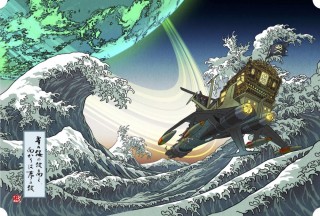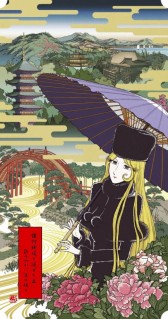Loading
Search
▼ Leiji Matsumoto Surfs the Floating World
- Category:Event
The work of manga artist Leiji Matsumoto mixes historical periods, themes and technologies, often in a science-fiction setting: His signature comics involve steam locomotives and reborn World War II battleships sailing among the stars. These grand flights of fancy, which have found fans around the world, become even more magical when transposed into a traditional Japanese art form, such as ukiyo-e, the “pictures of the floating world” from Japan’s Edo Period (1603-1868).
Matsumoto, 79, recently collaborated on a series of old-school woodblock prints with a modern twist in the form of his own characters and vehicles. In one, the titular romantic hero of “Space Pirate Captain Harlock” poses in samurai armor before Kumamoto Castle under the light of an oversized moon. In another, the mysterious Maetel from “Galaxy Express 999” is depicted in a classic Kyoto scene of flowers, golden clouds and a pagoda. Another carving features Harlock’s ship Arcadia sailing over Katsushika Hokusai’s “Great Wave off Kanagawa” with a ringed planet in the background. The six works were made in limited sets of 1,000 prints and are selling from ¥95,000 each; part of the proceeds go to Kumamoto quake recovery efforts. The woodblock prints were produced in collaboration with Kyoto-based woodblock studio Takezasado, Team Hirota, a creative group led by Takeshi Hirota, and Living National Treasure Ichibei Iwano IX, a washi paper master.
“It’s wonderful to be able to enter the world of ukiyo-e, which is something handed down from days of old,” Matsumoto, sporting his trademark skull-and-bones cap, says in an interview at the Sumida Hokusai Museum in Tokyo’s Sumida Ward. “I became a big fan of Hokusai’s manga at an early age and it had a significant impact on my work. Actually, ukiyo-e works have an established atmosphere, so I was worried about ruining this genre with my own work.” Matsumoto is no stranger to collaborations. In 2001, he teamed up with French electronic music group Daft Punk to produce an animated feature based on their album “Discovery.” Last year, he did a joint exhibition at the Kobe Artists Museum with his wife Miyako Maki, a former manga artist known for creating Licca-chan, the popular dress-up doll.
Born in Fukuoka in 1938, Matsumoto grew up during the war, which profoundly colored his oeuvre. He began drawing manga at age 5, and won a Manga Shonen Best New Writer prize in 1954. He achieved superstardom in the 1970s with titles such as “Space Battleship Yamato,” a sci-fi epic centering on humanity’s war against invading aliens and the resurrection of the legendary battleship Yamato as a spaceship.
Matsumoto also penned shōjo (girls’) manga and comics about the war. He even designed the popular Sumida River pleasure boat Himiko, known for its sleek lines. History, the origins and future of humanity and the environment have always been prominent themes.
“When I was a child, and indeed throughout my life, I was always thinking and reading about the Earth and sentient beings in the past, present and future,” Matsumoto says. “I grew up watching many American cartoons like Mickey Mouse and movies, especially ‘Gone With the Wind,’ and that memorable scene in which Scarlett O’Hara swears, ‘I’ll never be hungry again.'” Fate and individual struggle have been strong motifs for Matsumoto. He recalls how manga pioneer Osamu Tezuka, who was 10 years his senior, happened to see the 1943 Disneyesque anime “The Spider and the Tulip,” Japan’s first musical animation, on the same day and time as him. Both young artists would go on to produce works inspired by insects and also become science fiction legends. Matsumoto, his eye always on other worlds, says he still believes that intelligent aliens once lived on Venus, left traces of cities behind and may have fled to Earth long ago. They may have been ancestors of the human race, he says.
It’s at this point that I notice Matsumoto’s eyes are blue. A sign of alien, or at least foreign, ancestry?
“I hadn’t noticed,” he says with a laugh. “My grandfather had a bit of blue in his eyes, too. After I created the character Maetel, I researched my family history, and in a temple next to my home I found a daguerreotype of an ancestor who looked and dressed just like her. This genetic memory is formidable.”
For more information on Leiji Matsumoto’s collaborations, visit broadexpert.tokyo.
Matsumoto, 79, recently collaborated on a series of old-school woodblock prints with a modern twist in the form of his own characters and vehicles. In one, the titular romantic hero of “Space Pirate Captain Harlock” poses in samurai armor before Kumamoto Castle under the light of an oversized moon. In another, the mysterious Maetel from “Galaxy Express 999” is depicted in a classic Kyoto scene of flowers, golden clouds and a pagoda. Another carving features Harlock’s ship Arcadia sailing over Katsushika Hokusai’s “Great Wave off Kanagawa” with a ringed planet in the background. The six works were made in limited sets of 1,000 prints and are selling from ¥95,000 each; part of the proceeds go to Kumamoto quake recovery efforts. The woodblock prints were produced in collaboration with Kyoto-based woodblock studio Takezasado, Team Hirota, a creative group led by Takeshi Hirota, and Living National Treasure Ichibei Iwano IX, a washi paper master.
“It’s wonderful to be able to enter the world of ukiyo-e, which is something handed down from days of old,” Matsumoto, sporting his trademark skull-and-bones cap, says in an interview at the Sumida Hokusai Museum in Tokyo’s Sumida Ward. “I became a big fan of Hokusai’s manga at an early age and it had a significant impact on my work. Actually, ukiyo-e works have an established atmosphere, so I was worried about ruining this genre with my own work.” Matsumoto is no stranger to collaborations. In 2001, he teamed up with French electronic music group Daft Punk to produce an animated feature based on their album “Discovery.” Last year, he did a joint exhibition at the Kobe Artists Museum with his wife Miyako Maki, a former manga artist known for creating Licca-chan, the popular dress-up doll.
Born in Fukuoka in 1938, Matsumoto grew up during the war, which profoundly colored his oeuvre. He began drawing manga at age 5, and won a Manga Shonen Best New Writer prize in 1954. He achieved superstardom in the 1970s with titles such as “Space Battleship Yamato,” a sci-fi epic centering on humanity’s war against invading aliens and the resurrection of the legendary battleship Yamato as a spaceship.
Matsumoto also penned shōjo (girls’) manga and comics about the war. He even designed the popular Sumida River pleasure boat Himiko, known for its sleek lines. History, the origins and future of humanity and the environment have always been prominent themes.
“When I was a child, and indeed throughout my life, I was always thinking and reading about the Earth and sentient beings in the past, present and future,” Matsumoto says. “I grew up watching many American cartoons like Mickey Mouse and movies, especially ‘Gone With the Wind,’ and that memorable scene in which Scarlett O’Hara swears, ‘I’ll never be hungry again.'” Fate and individual struggle have been strong motifs for Matsumoto. He recalls how manga pioneer Osamu Tezuka, who was 10 years his senior, happened to see the 1943 Disneyesque anime “The Spider and the Tulip,” Japan’s first musical animation, on the same day and time as him. Both young artists would go on to produce works inspired by insects and also become science fiction legends. Matsumoto, his eye always on other worlds, says he still believes that intelligent aliens once lived on Venus, left traces of cities behind and may have fled to Earth long ago. They may have been ancestors of the human race, he says.
It’s at this point that I notice Matsumoto’s eyes are blue. A sign of alien, or at least foreign, ancestry?
“I hadn’t noticed,” he says with a laugh. “My grandfather had a bit of blue in his eyes, too. After I created the character Maetel, I researched my family history, and in a temple next to my home I found a daguerreotype of an ancestor who looked and dressed just like her. This genetic memory is formidable.”
For more information on Leiji Matsumoto’s collaborations, visit broadexpert.tokyo.
- April 7, 2017
- Comment (0)
- Trackback(0)





